The desert between
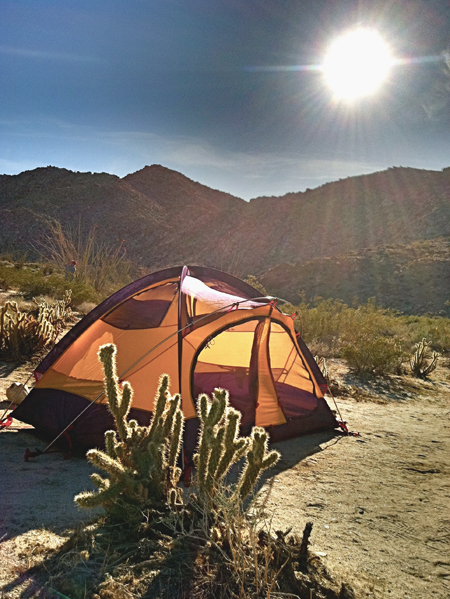 It exhibits questionable judgment to leave Phoenix right now when the Sonoran desert is so beautiful, but we did. In a fit of really-needing-to-get-out-of-town E and I enacted a spur of the moment plan for a busman’s holiday of camping in the Colorado desert*. We took off down I-8 in the footsteps of Juan Bautista deAnza himself, headed towards a bit of California desert between our desert in Phoenix and the desert under the currently snow-capped Peninsular peaks east of San Diego (see photo below, be sure to click to enlarge).
It exhibits questionable judgment to leave Phoenix right now when the Sonoran desert is so beautiful, but we did. In a fit of really-needing-to-get-out-of-town E and I enacted a spur of the moment plan for a busman’s holiday of camping in the Colorado desert*. We took off down I-8 in the footsteps of Juan Bautista deAnza himself, headed towards a bit of California desert between our desert in Phoenix and the desert under the currently snow-capped Peninsular peaks east of San Diego (see photo below, be sure to click to enlarge).
<< our tent above Bow Willow (all photos A.Shock unless noted)
Between. We arrived at the south end of Anza-Borrego State Park between weekends (it was spring break at ASU, so E was more or less at liberty mid-week). The weather was a slice of unseasonable summer between winter and spring, topped by a dry blue sky between pacific storms and a tarry, star-salted night sky between moons. It was a waiting wing of a moment, a pared-down parcel of between, when all that was in the desert was what was always there, the patient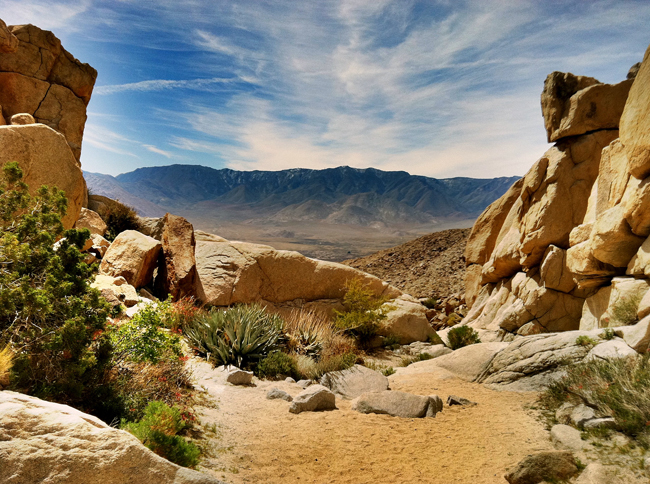 bare granite bones, the sun, cactus, creosote, and cool, rustling palms: the permanent residents. Ephemerals — the summer-breeding birds and annual wildflowers — hadn’t appeared in any numbers, yet.
bare granite bones, the sun, cactus, creosote, and cool, rustling palms: the permanent residents. Ephemerals — the summer-breeding birds and annual wildflowers — hadn’t appeared in any numbers, yet.
>> Overlooking the Carrizo Valley and the snow-dusted Tierra Blanca Mtns from the notch at the end of Smuggler’s Canyon
Arriving in any desert for peak wildflower bloom or migration at an oasis is serendipitous: we’ve managed it occasionally, sometimes by accident and sometimes on purpose — once for a songbird jam at Butterbredt Springs in the Mojave and twice for “jubilee” blooms in Death Valley only a few years apart. These were times we effortlessly tripped over the attractions and high points, unable to look away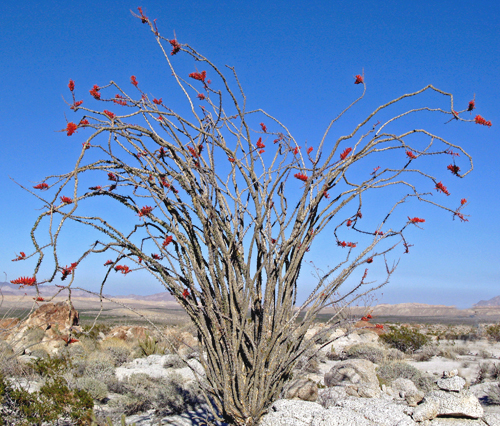 from showers of jewel-colored orioles and tanagers and thick carpets of bright petals. This between season was different: we had to look hard and close for things — the serendipity took more effort.
from showers of jewel-colored orioles and tanagers and thick carpets of bright petals. This between season was different: we had to look hard and close for things — the serendipity took more effort.
Ocotillo (Fouquieria splendens) being very splendid indeed; this one was about 10 feet tall >>
But the desert seldom disappoints and though between, this trip was no exception. The beavertail prickly pear, studded with fat pink-green buds, were clearly about to burst into glorious magenta bloom only after we were gone. But the tips of the Ocotillo were in flame, and in the few days we were there their thorny bleached stems scaled over with green leaves. Little fishhook cactus rocked coronas of creamy blossoms that looked glued onto their heads like fake straw flowers on a hat. 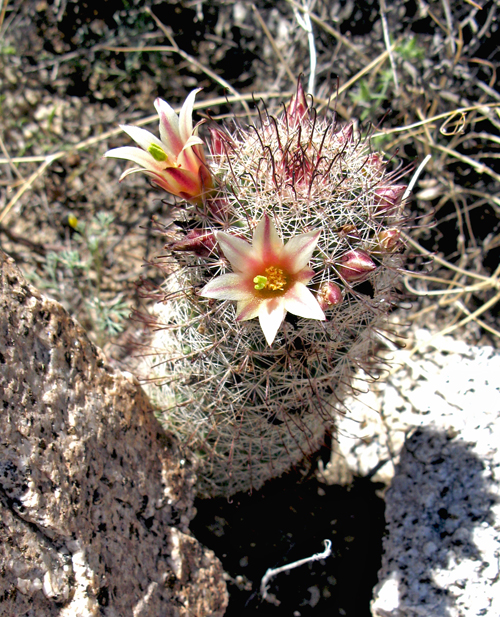 In places, a tide of tiny goldfields washed around the feet of gray wintery shrubs (see photo at bottom of post). The mesquite and desert willows were still bare, but the Elephant trees (Bursera microphylla) were green with their incense-scented leaflets, and deer vetch, creosote, and desert lavender were all blooming. Tangles of red-flowered chuparosa scrambled over granite boulders, and in tight crevices fronds of “resurrection plant” or desert mossfern (Selaginella sp) unfurled, instantly green and pliant after recent rains.
In places, a tide of tiny goldfields washed around the feet of gray wintery shrubs (see photo at bottom of post). The mesquite and desert willows were still bare, but the Elephant trees (Bursera microphylla) were green with their incense-scented leaflets, and deer vetch, creosote, and desert lavender were all blooming. Tangles of red-flowered chuparosa scrambled over granite boulders, and in tight crevices fronds of “resurrection plant” or desert mossfern (Selaginella sp) unfurled, instantly green and pliant after recent rains.
<< “Fishhook cactus” Mammillaria (probably) dioica. They need no more than a fracture in rock for a foot-hold, and seem to require no soil at all.
Birds were also in a between season: Rock wrens and Black-throated sparrows, present year-round on the rocky hillsides, were ubiquitous and vocal, along with Cactus and Canyon wrens, Costa’s hummers, quail, and ravens.  There were only occasional passers-through: a Lincoln’s sparrow in the palm oasis; surprising numbers of Sage thrashers moving through the Bow Willow wash. But the summer visitors were barely starting to trickle in — we found a couple of male Scott’s orioles alternately singing their ringing song and molesting nectar-oozing Ocotillo flowers, a Common Yellowthroat working the dense understory at the palm grove, and an Ash-throated flycatcher k-brkk‘ed near the campsite.
There were only occasional passers-through: a Lincoln’s sparrow in the palm oasis; surprising numbers of Sage thrashers moving through the Bow Willow wash. But the summer visitors were barely starting to trickle in — we found a couple of male Scott’s orioles alternately singing their ringing song and molesting nectar-oozing Ocotillo flowers, a Common Yellowthroat working the dense understory at the palm grove, and an Ash-throated flycatcher k-brkk‘ed near the campsite.
A Black-throated sparrow; who says sparrows are plain? (photo E.Shock) >>
Surprisingly, we were between when it came to snakes, too — we saw none, but I’m sure they were out. On the other hand, lizards were plentiful. Blue-bronze Granite Spiny lizards basked, and we were ignored hard by a harlequin Baja California Collared lizard sunning on a boulder right next to the trail.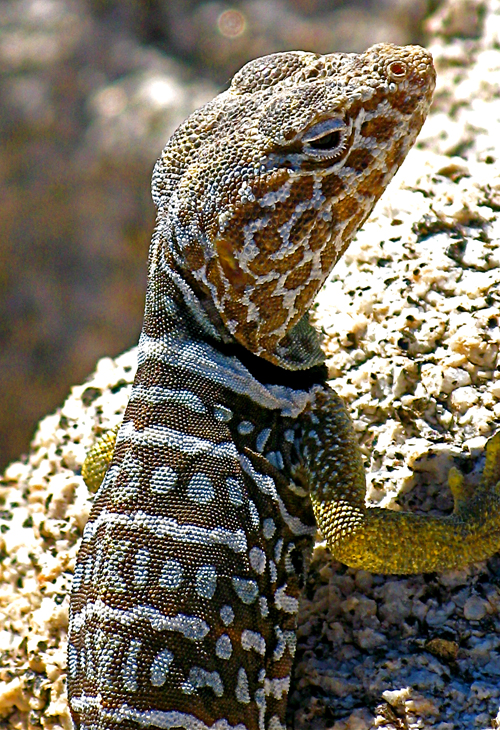
<< Baja California Collared lizard (Crotaphytus vestigium) is a species of collared lizard found only in a small range in the US, as its name indicates.
The only disappointment of being between was that our transportation was between, too: we discovered after arriving that the truck’s four wheel drive wouldn’t lock in, leaving us with high-clearance passage but wimpy traction. This wasn’t an emergency but it ruled out more remote, difficult roads — we could only go where two-wheel drive or our two feet could take us, which turned out to be plenty for the short time we had. But we missed some interesting habitat like the Carrizo Marsh, and intriguing, fossiliferous geology that E is itching to check out.
We’ll have to get that 4-wheel drive fixed so that instead of between, next time we’ll definitely be smack-dab.
Low carpet of yellow wildflowers I know only as “Goldfields” >>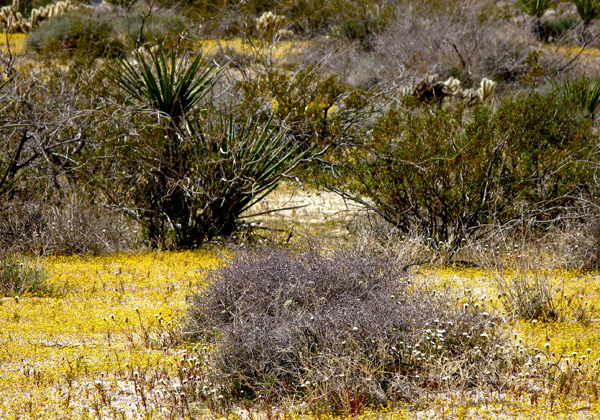
* The term “Colorado Desert” generally refers to the portion of the Sonoran Desert that lies within the state of California.

What a stupendous lizard!
And it was very very large!
On my marathon drive home from Yuma 2 Januarys ago, just as my route turned north towards the Salton Sea, those mountains beckoned to me from the western distance, all freshly snow-trimmed and the air so clear it made me cry. I am such a bear-went-over -the-mountain gal, it was very hard not to keep driving west just to investigate. Glad you did and brought back these stunning photos.
Great pics and story, makes me want to pack my camera and go!
Nashie, you’d love having your camera in the desert — so many great photo ops!
Sue, it’s all good down there — as you know, the interstates only let you know by contrast what you’re missing just off their edges!